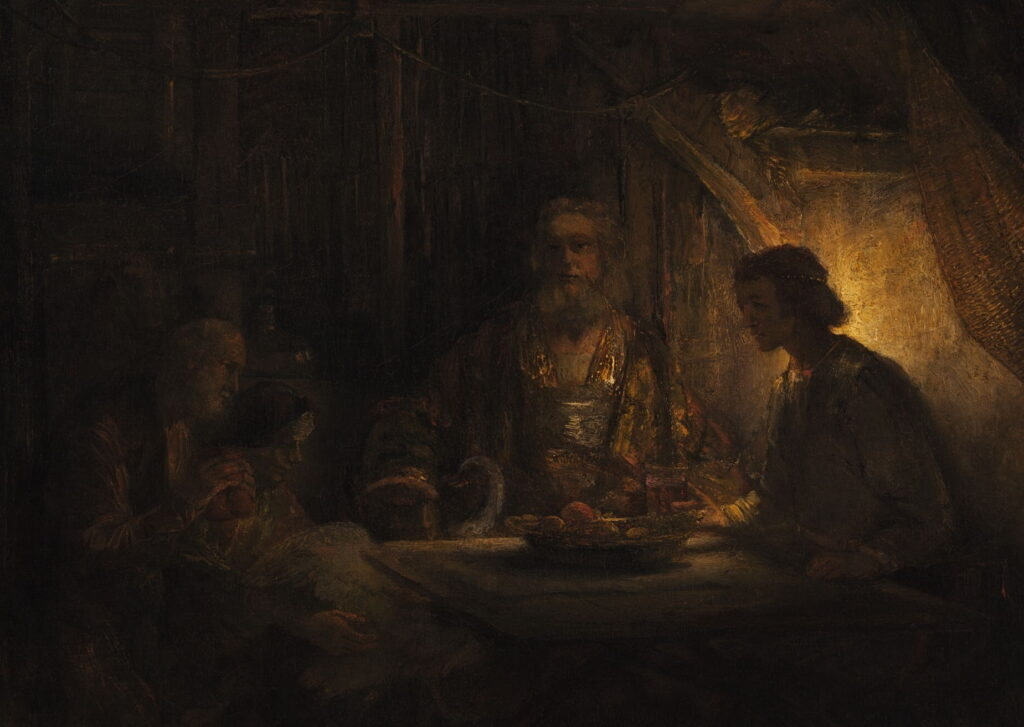Changing Paintings: 40 Hospitality to strangers and virtue rewarded

Achelous the river god is hosting Theseus, Ixion’s son Lelex, and others at a banquet. Once Achelous has told the story of the nymphs who were turned into the Echinades, Lelex launches into the next, of Philemon (husband) and Baucis (wife). This is one of Ovid’s most touching myths, which doesn’t appear in any other source.
Lelex claims that Achelous made the gods appear too great, so tells his story to prove that whatever the gods decree will happen does take place. His story is set in Phrygia (now west central Anatolia, in Turkey), at a place where an oak and a lime tree grow side by side. Nearby is a marsh, where once the land was habitable, and Lelex explains how those came to be.
One day, Jupiter and his son Mercury were walking in Phrygia. When they grew tired and wanted to rest, they tried a thousand homes, but every one rejected the visitors, until they came to a poor thatched cottage. There they met the elderly Philemon and Baucis, who had married in their youth, and had lived good and pious lives together ever since. The couple welcomed the gods into their tiny and humble home.
Philemon and Baucis waited on their guests’ every needs, lighting a fire, providing them with warm water to bathe their feet, then serving them food and wine; the latter was strange, because as fast as they could pour wine into their guests’ beechwood goblets, the pitcher of wine refilled itself. The couple tried to catch the goose that guarded their cottage, to kill and cook it for their guests, but it ran to the safety of a guest’s lap.
Adam Elsheimer (1578–1610), Jupiter and Mercury with Philemon and Baucis (1609-10), oil on copper, 16.5 x 22.5 cm, Gemäldegalerie Alte Meister, Dresden. Wikimedia Commons.
Adam Elsheimer’s exquisite oil on copper painting of Jupiter and Mercury with Philemon and Baucis (1609-10) shows Philemon (right) and Baucis (centre right) giving their hospitality generously to Jupiter (left) and Mercury (centre left), in their tiny, dark cottage. All four are depicted in contemporary dress, although Mercury’s winged helmet is an unmistakeable clue as to his identity. Their modest stock of food is piled in a basket in the right foreground, and the goose is just distinguishable in the gloom at the lower edge of the painting, below Mercury’s feet.
David Rijckaert (III) (1612–1661), Philemon and Baucis Giving Hospitality to Jupiter and Mercury (date not known), oil on panel, 54 x 80 cm, Private collection. Wikimedia Commons.
David Rijckaert’s undated painting of Philemon and Baucis Giving Hospitality to Jupiter and Mercury provides the basis of what has become the most popular depiction: Mercury (left) and Jupiter (left of centre) seated at the table, with Philemon (behind table) and Baucis (centre) waiting on their every need. Baucis has almost caught the evasive goose, and an additional figure is in the background preparing and serving food for the gods. Rijckaert adds some subtle details such as Jupiter’s eagle perched in the rafters.
Rembrandt Harmenszoon van Rijn (1606–1669), Baucis and Philemon (1658), oil on panel mounted on panel, 54.5 × 68.5 cm, The National Gallery of Art, Washington, DC. Courtesy of The National Gallery of Art, via Wikimedia Commons.
Rembrandt’s Baucis and Philemon (1658) is one of his late works, and shows Jupiter looking decidedly Christlike, and Mercury the younger, almost juvenile, figure, sat at the table of a dark and rough cottage, lit by a lamp behind Mercury. This dramatic lighting is precursor to similar effects in his later Ahasuerus and Haman (1660) and Conspiracy of the Batavians (1661-2). Philemon and Baucis are crouched, chasing the evasive goose towards Jupiter. A humble bowl of food is in the centre of the table, and there is a glass of beer. As is usual in Rembrandt’s narrative paintings, he dresses them in contemporary rather than historic costume.
Rembrandt Harmenszoon van Rijn (1606–1669), Baucis and Philemon (detail) (1658), oil on panel mounted on panel, 54.5 × 68.5 cm, The National Gallery of Art, Washington, DC. Courtesy of The National Gallery of Art, via Wikimedia Commons.
Although Rembrandt created many wonderfully narrative paintings, he seldom depicted stories from Ovid’s Metamorphoses. He has made the painting using rough brushstrokes and highly gestural marks of paint, as roughly hewn as the cottage which it depicts. It isn’t just an outstanding account of this myth, but one of his finest narrative paintings.
Johann Carl Loth (1632–1698), Jupiter and Mercury with Philemon and Baucis (c 1659-62), oil on canvas, 178 x 232.5 cm, Kunsthistorisches Museum, Vienna. Wikimedia Commons.
Johann Carl Loth, in his Jupiter and Mercury with Philemon and Baucis (c 1659-62), appears to have reworked the narrative from Ovid’s original. While Baucis and Philemon are waiting on their guests, with Philemon holding the jug containing wine, Mercury (centre) appears to be remonstrating with Jupiter (right), holding out his right index finger and pointing it at the other god. The evasive goose is shown behind Mercury’s back, apparently about to peck his left hand. The whole scene is set in a well-lit area, perhaps outside the cottage in daylight.
Andrea Appiani (1754–1817), circle of, possibly Stefano Tofanelli (1752-1812) or Pietro Benvenuti (1769-1844), Jupiter and Mercury with Philemon and Baucis (date not known), oil on canvas, 164 x 170 cm, Private collection. Wikimedia Commons.
This painting from the circle of Appiani, possibly by Stefano Tofanelli or Pietro Benvenuti, shows Jupiter and Mercury with Philemon and Baucis in less straitened circumstances. Jupiter (left) holds a glass of wine in his left hand, and Mercury (centre) is both eating grapes and looking longingly at a fresh bowl of fruit that Philemon (right) is just about to place on the table. Baucis (front right) is looking at Jupiter, and holding out her right hand, as if to refill his glass.
The gods then revealed their divinity, and told their hosts that those who had shunned them would pay for their wickedness, but the old couple would be spared. Jupiter and Mercury then took them outside, and led them up the nearby mountain. When close to the top, Philemon and Baucis looked back to see all the land below was flooded, except for their tiny cottage, which had been transformed into a temple with a roof of gold.
Peter Paul Rubens (1577–1640), Stormy Landscape with Philemon and Baucis (c 1625?), oil on oak, 146 × 208.5 cm, Kunsthistorisches Museum, Vienna. Wikimedia Commons.
Peter Paul Rubens’ Stormy Landscape with Philemon and Baucis from about 1625 is one of the few paintings to show a broader view of this later moment in Ovid’s story. His dramatic landscape shows storm-clouds building over the hills, a raging torrent pouring down the mountainside, dragging large trees and animals in its swollen waters, and the four figures on a track at the right. Philemon and Baucis are struggling up the track with their sticks, Jupiter points to a rainbow formed over a waterfall at the lower left corner, and Mercury is all but naked.
Jupiter then asked the couple what they most wanted. After a moment’s consultation, they agreed that they wanted to be the priests of that temple, and that, when their time came, they should both die together. Their wish was granted, and later, when they were even older, they both turned into an intertwining pair of trees, one an oak, the other a lime (linden), just as Lelex had described.
